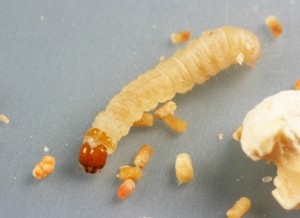Every now and then a couple of moths make an appearance in my kitchen or dining room. Beyond being a minor nuisance, they are a signal I have eggs, larva and pupa in some food product nearby. These moths are called pantry pests, specifically, Indian Meal Moths. Their Latin name is Plodia interpunctella. They feed on and infest grain products such as flour, oatmeal, cornmeal and just about any cereal. They are also known to eat dried fruit, chocolate, herbs and seeds. Insects are usually brought into the home unnoticed in food products from the grocery store and might occasionally fly in from an outside food source. Some unusual hiding and egg laying places have been reported to the UConn Home and Garden Education Center. The crumb tray of the toaster, the intake vents of stand mixers, in the pot holder drawer feeding on crumbs, in stored seeds for the vegetable garden and in the bottom of the holiday nut bowl are all additional sites of egg laying. Dry pet food and bird seed can contain Indian Meal Moths.
The lifecycle of Indian Meal Moth has four stages. The adult female moth will lay 60 to 300 eggs in or near a food source. The egg hatches into a larva within 2 to 14 days, then begins feeding for a varying number of days, depending on temperature and humidity. They then pupate during which they develop into a moth, emerge to fly around our kitchens, mate and repeat the cycle. Moths sometimes lay eggs on textured ceilings and at the corners where the wall meets the ceiling and on the underside of the cabinet shelves.
Signs they larvae are present in dry-stored foods are webbing and frass clumping food bits together and hanging from the top or sides of containers. In the case of the toaster tray, all of the crumbs were not loose but matted together in one lump. Adults and larva can chew through cardboard and plastic bags. It is best to store even unopened packages in hard sided plastic or glass containers. That way, even if you bring the insects in from the grocery store, they will be contained in the hard container.
Control measures include vacuuming and cleaning cabinets, examining food for any insect presence and removing. Soap and water will kill all stages of life of these soft bodied insects. Pesticides are not needed and not recommended indoors, especially around food. Keep cabinets clean, wipe up spilled food promptly and good sanitation practices will eliminate any food sources for any moths you might have missed. Placing suspected infested food containers in the freezer will kill the insects. The insects are not vectors of any human disease and will not harmful if eaten, but a little gross!
-Carol Quish


